
Welcome to our Australian Currency page. Below is some information to help you learn and understand how it all started and where we are today in terms of our currency.
Please note: All notes displayed are showing the front of the note first, then the back.
Images may take a minute or two to load if your on a dial up connection. Please be patient.

In 1913, the first Commonwealth of Australia Ten Shilling notes were printed in Melbourne. A further three denominations were issued in that year - the One Pound, Five Pound and the Ten Pound notes. The large denomination notes ranging from 20, 50, 100 and 1000 Pound were all in circulation by 1914 and continued until 1938 when the 20 Pound was withdrawn, followed by the 50 and 100 Pound in 1945. (The 1000 Pound note had been withdrawn from general circulation on June 30th. 1915 - all known stocks were destroyed in 1969.)
The remaining Imperial denominations were continued until the major shake-up when decimal currency arrived in 1966, and a completely new philosophy was adopted. This saw the introduction of coins in denominations of 1, 2, 5, 10, 20 and 50 cents and the introduction of notes in 1, 2, 5, 10, 20, 50, and 100 dollars.
The $1 and $2 notes were eventually replaced with coins and in recent years the 1 and 2 cent coins have been removed from circulation with amounts rounded up or rounded down to the nearest 5 cents.
When the new polymer plastic technological breakthrough was announced in 1988, the eventual demise of paper currency in Australia was inevitable. The new designs feature eight Australian pioneers who had contributed a great deal to Australia.

5 cent
The reverse side depicts a curled up echidna. The echidna is closely related to the platypus. The echidna and platypus are the only mammals in the world that produce their young in eggs. After hatching they feed on their mother's milk until they can forage for their own food.
The echidna lives in hollows, under trees, or among rocks found in many parts of Australia, from semi-desert to rainforests. They probe for ants and termites with their snout and lick them up with their long sticky tongue. If disturbed the echidna is able to burrow straight down very quickly.

10 cent
The reverse side features the lyrebird displaying its beautiful tail feathers. The tail feathers of the male are similar in shape to the ancient musical instrument, the lyre, hence the name lyrebird.
The lyrebird is found only in Australia and lives in the damp forests from Victoria to southern Queensland.

20 cent
The reverse side features the platypus. The platypus and echidna are the only mammals in the world, which produce their young in eggs. The young suck milk from glands in the fur on the mother's belly. Often called the duckbilled platypus, because its snout is shaped like a duck's bill, the platypus has webbed feet to help it swim in search of small prawns, worms and insect larvae.
The platypus nest in burrows on the banks of streams and rivers in eastern Australia.

50 cent
The Australian Coat of Arms unites the six state badges on a central shield. The ermine border signifies the federation of the states into the Commonwealth of Australia. A kangaroo and emu with a background of Australia's national flower, the golden wattle, support the shield.
The fifty cent coin is the only Australian circulating coin that is not round - it is dodecagonal.

$1
The reverse of the one dollar coin features kangaroos. They are part of the order of mammals called marsupials. The kangaroo can vary in size from mouse size to over two metres. Kangaroos are found all over Australia, they eat grass and green vegetation. The one dollar coin was minted to replace the note because notes only lasted in circulation for about eight months, while coins average 30 years.

$2
The design on the reverse of the two dollar coin shows an Aboriginal tribal elder against a background of the Southern Cross constellation and native grass tree plants. The two dollar coin was introduced in 1988 to replace the two dollar note issued in 1966.

These images and information was obtained from the Royal Australian Mint website. The RAM is located in the Australian Capital Territory.

$5
The five dollar note features Queen Elizabeth II on the obverse side while the reverse side has a representation of Parliament house. Like all of our new polymer notes, it features anti-counterfeiting measures including clear windows of the polymer that makes up the note making it nearly impossible for colour photocopiers to replicate.


$10
The $10 note features Andrew Barton Paterson C.B.E. (Commander of the Order of the British Empire) on the obverse, and Dame Mary Gilmore on the reverse.

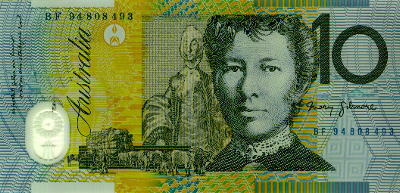
$20
The $20 note features Mary Reibey on the obverse, and Dr John Flynn on the reverse.


$50
The $50 note obverse side features Australia's first published Aboriginal author, David Unaipon, and as its reverse it features Edith Dircksey Cowan O.B.E., the first woman to hold a seat in an Australian Parliament.
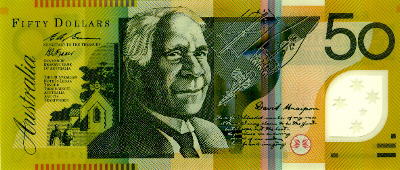
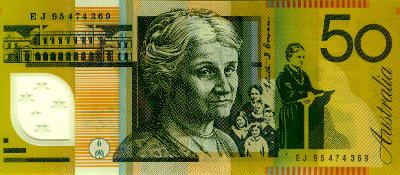
$100
The $100 note features two Australians who followed totally different paths to success. Both are credited with doing great things towards giving our nation the necessary credentials to take its place amongst the best in the world.
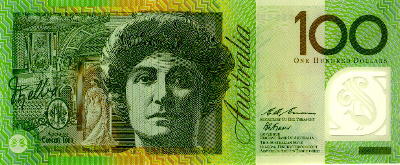
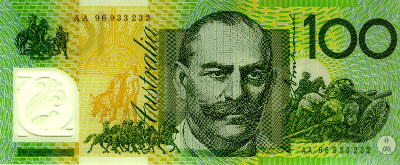
Thanks to Enigman for some information and images.
![]()